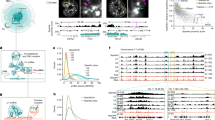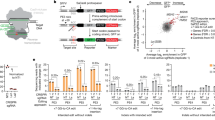Abstract
Transcription of eukaryotic messenger RNA (mRNA) encoding genes by RNA polymerase II (Pol II) is triggered by the binding of transactivating proteins to enhancer DNA, which stimulates the recruitment of general transcription factors (TFIIA, B, D, E, F, H) and Pol II on the cis-linked promoter, leading to pre-initiation complex formation and transcription1. In TFIID-dependent activation pathways, this general transcription factor containing TATA-box-binding protein is first recruited on the promoter through interaction with activators1,2,3 and cooperates with TFIIA to form a committed pre-initiation complex4. However, neither the mechanisms by which activation signals are communicated between these factors nor the structural organization of the activated pre-initiation complex are known. Here we used cryo-electron microscopy to determine the architecture of nucleoprotein complexes composed of TFIID, TFIIA, the transcriptional activator Rap1 and yeast enhancer–promoter DNA. These structures revealed the mode of binding of Rap1 and TFIIA to TFIID, as well as a reorganization of TFIIA induced by its interaction with Rap1. We propose that this change in position increases the exposure of TATA-box-binding protein within TFIID, consequently enhancing its ability to interact with the promoter. A large Rap1-dependent DNA loop forms between the activator-binding site and the proximal promoter region. This loop is topologically locked by a TFIIA–Rap1 protein bridge that folds over the DNA. These results highlight the role of TFIIA in transcriptional activation, define a molecular mechanism for enhancer–promoter communication and provide structural insights into the pathways of intramolecular communication that convey transcription activation signals through the TFIID complex.
This is a preview of subscription content, access via your institution
Access options
Subscribe to this journal
Receive 51 print issues and online access
$199.00 per year
only $3.90 per issue
Buy this article
- Purchase on Springer Link
- Instant access to full article PDF
Prices may be subject to local taxes which are calculated during checkout




Similar content being viewed by others
Accession codes
Data deposits
The electron density maps of the hydrated TFIID, the TFIID–TFIIA–DNA complex and the TFIID–TFIIA–Rap1–DNA complex I and complex II are deposited in the EM Database under accession numbers EM–5175, EM–5178, EM–5176 and EM–5177, respectively.
References
Burley, S. K. & Roeder, R. G. Biochemistry and structural biology of transcription factor IID (TFIID). Annu. Rev. Biochem. 65, 769–799 (1996)
Verrijzer, C. P. & Tjian, R. TAFs mediate transcriptional activation and promoter selectivity. Trends Biochem. Sci. 21, 338–342 (1996)
Jacq, X. et al. Human TAFII30 is present in a distinct TFIID complex and is required for transcriptional activation by the estrogen receptor. Cell 79, 107–117 (1994)
Lieberman, P. M. & Berk, A. J. A mechanism for TAFs in transcriptional activation: activation domain enhancement of TFIID-TFIIA–promoter DNA complex formation. Genes Dev. 8, 995–1006 (1994)
Papai, G. et al. Mapping the initiator binding Taf2 subunit in the structure of hydrated yeast TFIID. Structure 17, 363–373 (2009)
Elmlund, H. et al. Cryo-EM reveals promoter DNA binding and conformational flexibility of the general transcription factor TFIID. Structure 17, 1442–1452 (2009)
Grob, P. et al. Cryo-electron microscopy studies of human TFIID: conformational breathing in the integration of gene regulatory cues. Structure 14, 511–520 (2006)
Leurent, C. et al. Mapping histone fold TAFs within yeast TFIID. EMBO J. 21, 3424–3433 (2002)
Garbett, K. A., Tripathi, M. K., Cencki, B., Layer, J. H. & Weil, P. A. Yeast TFIID serves as a coactivator for Rap1p by direct protein-protein interaction. Mol. Cell. Biol. 27, 297–311 (2007)
Sussel, L. & Shore, D. Separation of transcriptional activation and silencing functions of the RAP1-encoded repressor/activator protein 1: isolation of viable mutants affecting both silencing and telomere length. Proc. Natl Acad. Sci. USA 88, 7749–7753 (1991)
Lieb, J. D., Liu, X., Botstein, D. & Brown, P. O. Promoter-specific binding of Rap1 revealed by genome-wide maps of protein–DNA association. Nature Genet. 28, 327–334 (2001)
Liu, W. L. et al. Structures of three distinct activator-TFIID complexes. Genes Dev. 23, 1510–1521 (2009)
Leurent, C. et al. Mapping key functional sites within yeast TFIID. EMBO J. 23, 719–727 (2004)
Layer, J. H., Miller, S. G. & Weil, P. A. Direct transactivator-transcription factor IID (TFIID) contacts drive yeast ribosomal protein gene transcription. J. Biol. Chem. 285, 15489–15499 (2010)
Sanders, S. L., Garbett, K. A. & Weil, P. A. Molecular characterization of Saccharomyces cerevisiae TFIID. Mol. Cell. Biol. 22, 6000–6013 (2002)
Tan, S., Hunziker, Y., Sargent, D. F. & Richmond, T. J. Crystal structure of a yeast TFIIA/TBP/DNA complex. Nature 381, 127–151 (1996)
Geiger, J. H., Hahn, S., Lee, S. & Sigler, P. B. Crystal structure of the yeast TFIIA/TBP/DNA complex. Science 272, 830–836 (1996)
Oelgeschlager, T., Chiang, C. M. & Roeder, R. G. Topology and reorganization of a human TFIID–promoter complex. Nature 382, 735–738 (1996)
Chalkley, G. E. & Verrijzer, C. P. DNA binding site selection by RNA polymerase II TAFs: a TAF(II)250–TAF(II)150 complex recognizes the initiator. EMBO J. 18, 4835–4845 (1999)
Mencia, M., Moqtaderi, Z., Geisberg, J. V., Kuras, L. & Struhl, K. Activator-specific recruitment of TFIID and regulation of ribosomal protein genes in yeast. Mol. Cell 9, 823–833 (2002)
Simonetti, A. et al. Structure of the 30S translation initiation complex. Nature 455, 416–420 (2008)
Konig, P., Giraldo, R., Chapman, L. & Rhodes, D. The crystal structure of the DNA-binding domain of yeast RAP1 in complex with telomeric DNA. Cell 85, 125–136 (1996)
Morse, R. H. RAP, RAP, open up! New wrinkles for RAP1 in yeast. Trends Genet. 16, 51–53 (2000)
Bleichenbacher, M., Tan, S. & Richmond, T. J. Novel interactions between the components of human and yeast TFIIA/TBP/DNA complexes. J. Mol. Biol. 332, 783–793 (2003)
Wang, W., Gralla, J. D. & Carey, M. The acidic activator GAL4-AH can stimulate polymerase II transcription by promoting assembly of a closed complex requiring TFIID and TFIIA. Genes Dev. 6, 1716–1727 (1992)
Lieberman, P. M., Ozer, J. & Gursel, D. B. Requirement for transcription factor IIA (TFIIA)-TFIID recruitment by an activator depends on promoter structure and template competition. Mol. Cell. Biol. 17, 6624–6632 (1997)
Ozer, J., Bolden, A. H. & Lieberman, P. M. Transcription factor IIA mutations show activator-specific defects and reveal a IIA function distinct from stimulation of TBP-DNA binding. J. Biol. Chem. 271, 11182–11190 (1996)
Shykind, B. M., Kim, J. & Sharp, P. A. Activation of the TFIID–TFIIA complex with HMG-2. Genes Dev. 9, 1354–1365 (1995)
Kokubo, T., Swanson, M. J., Nishikawa, J. I., Hinnebusch, A. G. & Nakatani, Y. The yeast TAF145 inhibitory domain and TFIIA competitively bind to TATA-binding protein. Mol. Cell. Biol. 18, 1003–1012 (1998)
van Heel, M. & Schatz, M. Fourier shell correlation threshold criteria. J. Struct. Biol. 151, 250–262 (2005)
Sanders, S. L. & Weil, P. A. Identification of two novel TAF subunits of the yeast Saccharomyces cerevisiae TFIID complex. J. Biol. Chem. 275, 13895–13900 (2000)
Rathjen, J. & Mellor, J. Characterisation of sequences required for RNA initiation from the PGK promoter of Saccharomyces cerevisiae . Nucleic Acids Res. 18, 3219–3225 (1990)
Ludtke, S. J., Baldwin, P. R. & Chiu, W. EMAN: semiautomated software for high-resolution single-particle reconstructions. J. Struct. Biol. 128, 82–97 (1999)
Tang, G. et al. EMAN2: an extensible image processing suite for electron microscopy. J. Struct. Biol. 157, 38–46 (2007)
Heymann, J. B. Bsoft: image and molecular processing in electron microscopy. J. Struct. Biol. 133, 156–169 (2001)
van Heel, M., Harauz, G., Orlova, E. V., Schmidt, R. & Schatz, M. A new generation of the IMAGIC image processing system. J. Struct. Biol. 116, 17–24 (1996)
Frank, J. et al. SPIDER and WEB: processing and visualization of images in 3D electron microscopy and related fields. J. Struct. Biol. 116, 190–199 (1996)
Pettersen, E. F. et al. UCSF Chimera - a visualization system for exploratory research and analysis. J. Comput. Chem. 25, 1605–1612 (2004)
Acknowledgements
This work was supported by grants from the Institut National de la Santé et de la Recherche Médicale, the Centre National pour la Recherche Scientifique, the Association pour la Recherche sur le Cancer, the Fondation pour la Recherche Médicale, the Agence Nationale pour le Recherche and the European SPINE program (G.P., C.R. and P.S., EU contract number QLG2-CT-00988), and the National Institutes of Health (M.K.T., J.H.L. and P.A.W., National Institutes of Health grant number GM52461).
Author information
Authors and Affiliations
Contributions
P.S. and P.A.W. initiated the study. M.K.T. purified the complexes and performed the biochemical tests. J.H.L. and M.K.T. participated in the design and production of mutant proteins. C.R. and G.P. performed the looping experiments. P.S. and G.P. prepared the samples for microscopy and recorded the images. G.P. performed the image analysis. The manuscript was prepared and commented on by P.S., P.A.W., M.K.T., J.H.L. and G.P.
Corresponding authors
Ethics declarations
Competing interests
The authors declare no competing financial interests.
Supplementary information
Supplementary Information
This file contains Supplementary Table 1, Supplementary Figures 1-12 with legends and References. (PDF 4022 kb)
Rights and permissions
About this article
Cite this article
Papai, G., Tripathi, M., Ruhlmann, C. et al. TFIIA and the transactivator Rap1 cooperate to commit TFIID for transcription initiation. Nature 465, 956–960 (2010). https://doi.org/10.1038/nature09080
Received:
Accepted:
Issue Date:
DOI: https://doi.org/10.1038/nature09080
This article is cited by
-
Ino2, activator of yeast phospholipid biosynthetic genes, interacts with basal transcription factors TFIIA and Bdf1
Current Genetics (2023)
-
Eukaryotic core promoters and the functional basis of transcription initiation
Nature Reviews Molecular Cell Biology (2018)
-
A heterochromatin-dependent transcription machinery drives piRNA expression
Nature (2017)
-
Multiple roles of the general regulatory factor Abf1 in yeast ribosome biogenesis
Current Genetics (2017)
-
Structure of promoter-bound TFIID and model of human pre-initiation complex assembly
Nature (2016)
Comments
By submitting a comment you agree to abide by our Terms and Community Guidelines. If you find something abusive or that does not comply with our terms or guidelines please flag it as inappropriate.



